Bulma’s Original Name Discovered
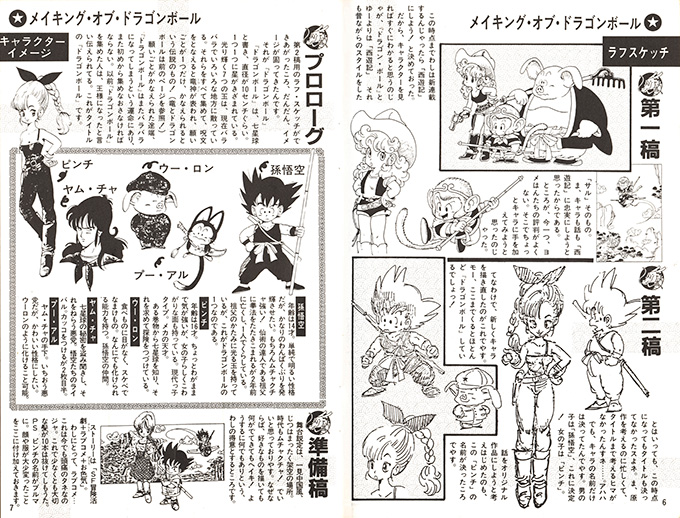
Did you know that Bulma had a name before it was Bulma?
It’s true! Akira Toriyama’s design concepts for Bulma, Son Gokū, Oolong, Yamcha, and Puar can be found in Bird Land Press #15 (November, 1984), pages 6 to 7, alongside their original names prior to publication of Dragon Ball Chapter 1 that same month.
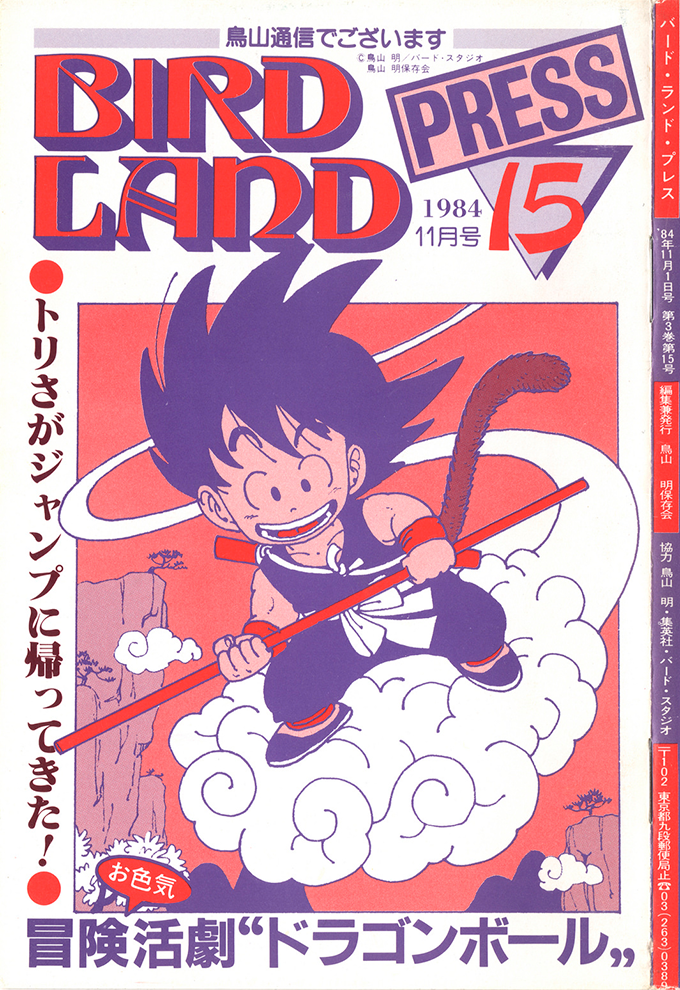
Bird Land Press was an Akira Toriyama-focused magazine that was published in Japan from 1982 to 1987. There were 25 issues in total.
These magazines are rare, and until now most of the interior content remained a mystery. Fortunately, a dedicated Dragon Ball fan in Brazil named Kami-sama recently purchased two of the magazines at an auction and has shared the content online.
With Kami-sama’s permission I have translated the content and am sharing it with you.
Let’s explore Toriyama’s concept art for the characters, as this will lead us to Bulma’s original and never-before-published name.
Dragon Ball Concept Art
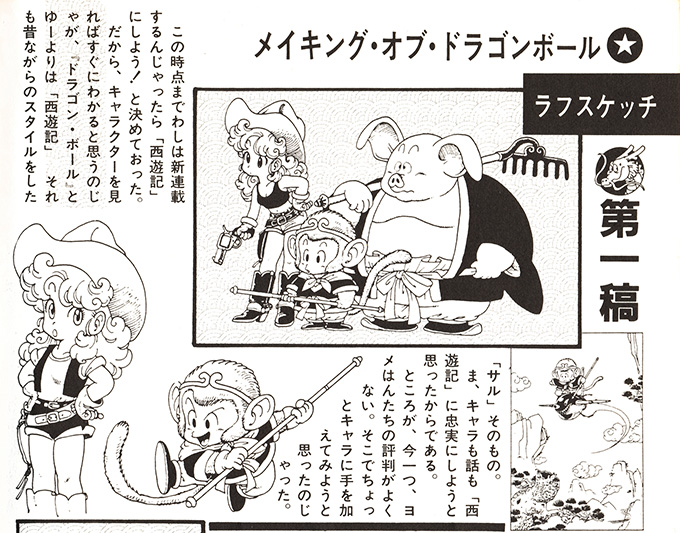
Here we see Son Gokū, Bulma, and Oolong, in their first incarnation.
In this version, Son Gokū and Oolong resemble their Xīyóujì (西遊記, Japanese: Saiyūki, “Journey to the West”) counterparts of Sūn Wùkōng and Zhū Bājiè.
Bulma on the other hand, instead of looking like the male Tang Monk, Xuánzàng, is now a girl and is dressed like a contemporary “Wild West Texan.” She has a cowboy hat, curly blonde hair, revealing top, daisy duke shorts, cowboy boots, and a revolver in her hand.
At the bottom right we can see Toriyama’s first version of the kintōun (“somersault cloud”), which is Sūn Wùkōng’s magical cloud in Xīyóujì. But instead of making it a cloud, Toriyama turns it into a flying meka with a shark nose paint job, like a World War II fighter jet. Gokū could have been flying on one of these for the entire series.
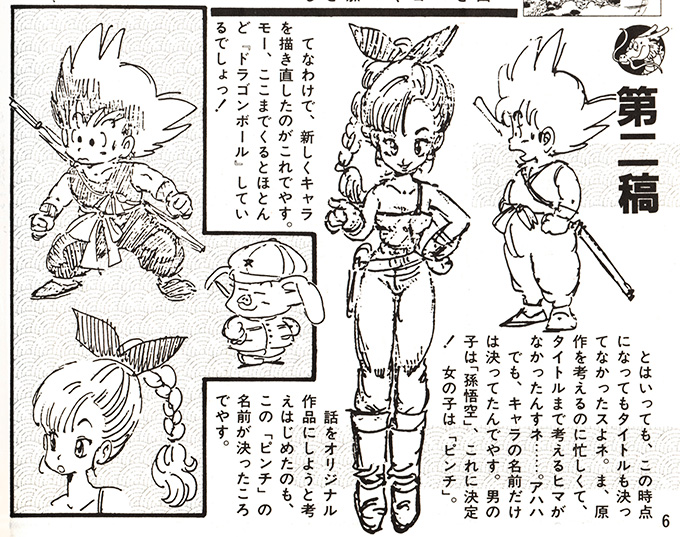
In the second draft, Toriyama changed their designs to be more contemporary.
Both characters are now cleaner and easier to understand. Gokū looks like a young boy wearing Chinese clothing, and without a tail. Bulma is a modern Western girl with tight pants, a revealing top, and a large bow in her hair. Oolong has also been changed to a short pig man wearing a Chinese Mao Suit, the clothes of the Chinese Communist Party.
Here we can see how Toriyama went through an iterative design process and changed the look and feel of his characters.

In this provisional draft we see Toriyama’s rendition of Gokū and Bulma as contemporary school children: One Western and one Eastern. Gokū is wearing a Japanese schoolboy’s uniform, which is the iconic sailor suit, while Bulma is wearing a fashionable Western outfit of a shirt and mini-skirt.
This design was intended for a more “Science Fiction Adventure” type of story. Here, Gokū is once again flying his meka instead of the kintōun.
Some fans may have already been familiar with these concept designs, as these pictures were also published in the Dragon Ball: Adventure Special (1987), the first guidebook to the series. But that book is also rare, and only surfaced within the last few years. More importantly, we now know that they first appeared in Bird Land Press #15, in November, 1984.
What’s new for everyone is this drawing.
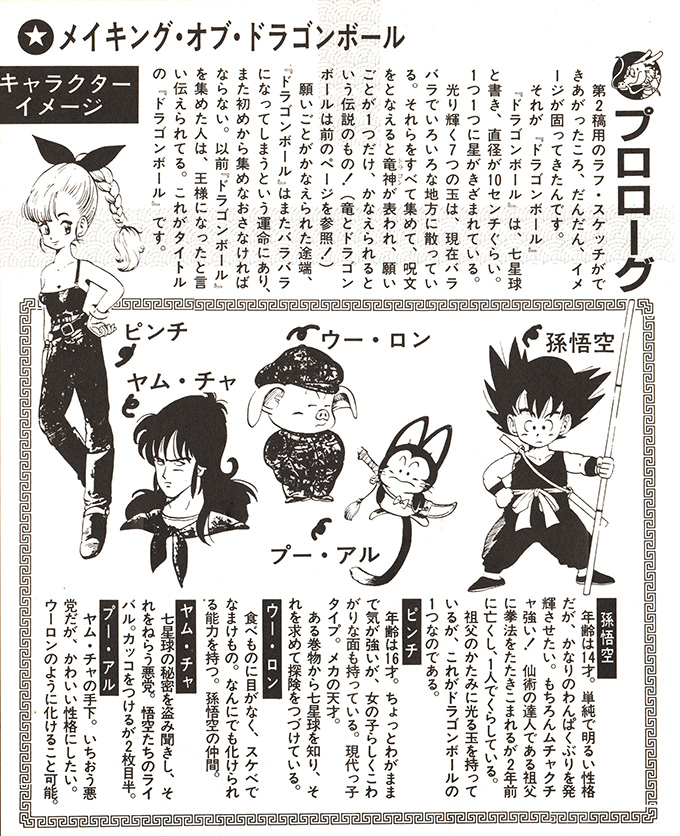
Titled “Prologue,” here we learn about the story before it was published. Below this we can see the names of the main characters, although most of them are different from how we know them.
Here are their names from right to left.
Son Gokū (孫悟空) is the only one that’s the same. This is because he’s named after the Monkey King, Sūn Wùkōng, and Son Gokū is the Japanese pronunciation of these kanji.
Pū Aru (プー・アル)
Ū Ron (ウー・ロン)
Yamu Cha (ヤム・チャ)
These three names have an interpunct (・) in the middle.
An interpunct is used in Japanese to separate foreign words from one another that are written in katakana. For example, a Westerner’s first and last name of Dave Smith would be Deibu Sumisu (デイブ・スミス).
So in these cases it’s like Toriyama is saying that there is a definite space in the middle of their names. Or at the very least they should be pronounced with this in mind. Note that he does not use the interpunct in the published manga.
These aren’t wildly different. However, here’s the kicker.
Next to Bulma he writes the name “Pinchi.” Not Buruma (ブルマ) as we know her today.
Etymology of Pinchi
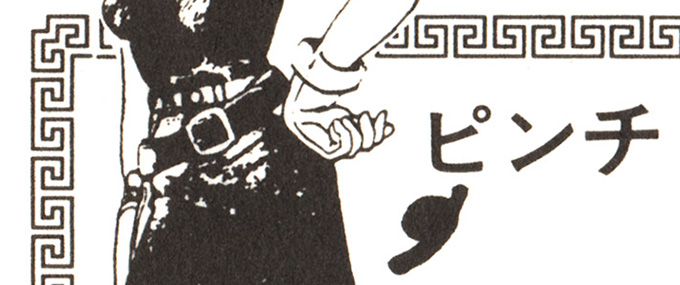
Pinchi (ピンチ, “pinch,” or “crisis”) is an English loanword that describes a “dire situation.” For example, “We’re in a real pinch!” or “How will our heroes escape this pinch?!” It’s a common term in anime and manga and we hear the Narration use this term quite a bit throughout Dragon Ball.
The question is, why would Toriyama name her Pinchi?
I presume it’s because her character is inspired by Xuánzàng in Journey to the West, who would often lead the group into dire situations. Chapter after chapter he’d walk into danger and then Sūn Wùkōng or the other pilgrims would have to rescue him. Toriyama intended this girl to be a female analog of Xuánzàng and Toriyama always tries to make his manga easy to understand, so by naming her Pinchi it would be easy for his young Japanese audience to understand that she is a girl associated with dangerous situations, just like Xuánzàng.
My second theory is that she’s a cute girl, the kind that you might want to pinch in the bum, so she’s Pinchi.
Another possibility is that Toriyama was thinking ahead. He doesn’t tend to do that, but consider the following.
Everyone in Bulma’s family is named after underwear. We have Buruma, Brief, Trunks, and Bra. Then there’s her mother, who is just referred to as Buruma-no-haha (ブルマの母, “Buruma’s Mother”). But if she does have a name, you figure it will be based on underwear, right? Toriyama says in Dragon Ball Forever, “Supposing I did name her, I would have probably used ‘Panchī.’ Not ‘Pantī.’”
This makes it seem like her name would be Panchī (パンチー), as a pun on Pantī (パンテ ィー, “panty”) because it would fit with their family’s theme. But if he had Panchī in mind, then Pinchi and Panchī might go together.
It’s a bit of a stretch, but it’s hard to know what Toriyama had in mind.
Here’s Pinchi’s character description, which I translated:
“Pinchi. 16 years old. Although strong in mind on the surface, this girl’s a little bit selfish and scared. She’s a modern type. Mechanical genius. Learning about seven starred balls from a scroll, she is on an expedition to search for the balls.”
(年齢は16才. ちょっとわがままで気が強いが, 女の子らしくこわがりな面も持っている.
現代っ予タイプ. メカの天才. ある巻物から星七球を知, それを求めて探険をつづけている.)
New info there being that she discovered the dragon balls “from a scroll.”
As you know, Pinchi was never published, and Toriyama instead went with Buruma. The question is why?
To find out, you can read my brand new book, Dragon Ball Culture Volume 2: Adventure. It’s available in print and ebook!
Dragon Ball Culture contains thousands of never before published revelations just like this one, including the complete origin of Son Gokū, from 3,000 years ago up to the present day. Dragon Ball Culture will forever change how you view your favorite series.
What do you think the origin of Pinchi is?
And how amazing is it that over 30 years later we’re still discovering new things about our favorite series?

Oh wow, that’s new. Great stuff as always!
Derek, is “Dragon Soul” not available as print book? I can only find it as e-book.
No, Dragon Soul is not yet available in print. Sorry for the delay. It’s a daunting project and overwhelmingly complicated because of all the images. And I’ve been busy with publishing Dragon Ball Culture. But I want to publish it as soon as I can.
I see. I’m looking very much forward to it.